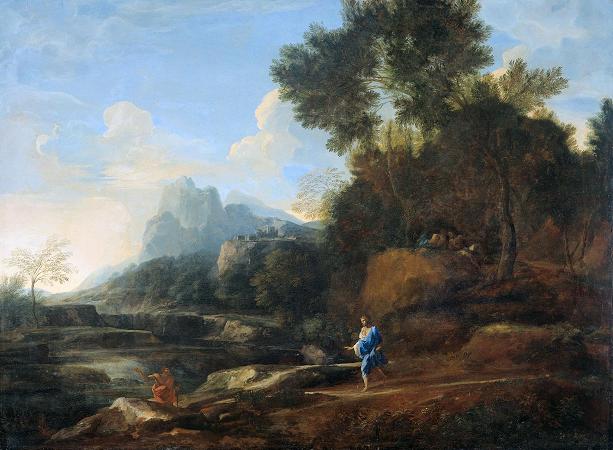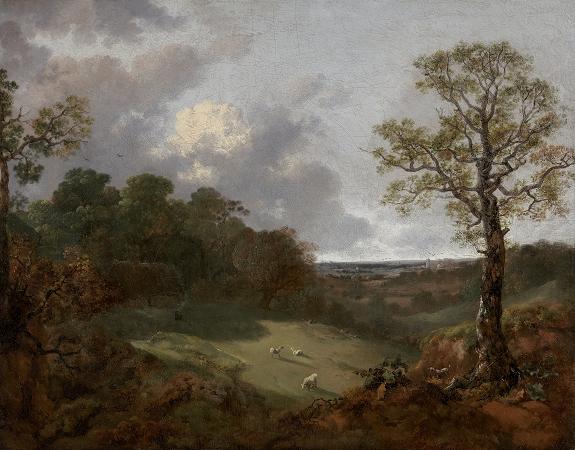Thomas Gainsborough (1727 - 1788). Thomas Gainsborough was an English portrait and landscape painter, draughtsman, and printmaker. Along with his rival Sir Joshua Reynolds, he is considered one of the most important British artists of the second half of the 18th century. He painted quickly, and the works of his maturity are characterised by a light palette and easy strokes. Despite being a prolific portrait painter, Gainsborough gained greater satisfaction from his landscapes. He is credited as the originator of the 18th-century British landscape school. Gainsborough was a founding member of the Royal Academy. He was born in Sudbury, Suffolk, the youngest son of John Gainsborough, a weaver and maker of woolen goods, and his wife, the sister of the Reverend Humphry Burroughs. One of Gainsborough's brothers, Humphrey, had a faculty for mechanics and was said to have invented the method of condensing steam in a separate vessel, which was of great service to James Watt; another brother, John, was known as Scheming Jack because of his passion for designing curiosities. The artist spent his childhood at what is now Gainsborough's House, on Gainsborough Street, Sudbury. He later resided there, following the death of his father in 1748 and before his move to Ipswich. The building still survives and is now a house-museum dedicated to his life and art. When he was still a boy he impressed his father with his drawing and painting skills, and he almost certainly had painted heads and small landscapes by the time he was ten years old, including a miniature self-portrait. Gainsborough was allowed to leave home in 1740 to study art in London, where he trained under engraver Hubert Gravelot but became associated with William Hogarth and his school. He assisted Francis Hayman in the decoration of the supper boxes at Vauxhall Gardens, and contributed one image to the decoration of what is now the Thomas Coram Foundation for Children. In 1746, Gainsborough married Margaret Burr, an illegitimate daughter of the Duke of Beaufort, who had settled a E200 annuity on her. The artist's work, then mostly consisting of landscape paintings, was not selling well. He returned to Sudbury in 1748-1749 and concentrated on painting portraits. In 1752, he and his family, now including two daughters, moved to Ipswich. Commissions for portraits increased, but his clientele included mainly local merchants and squires. He had to borrow against his wife's annuity. Towards the end of his time in Ipswich, he painted a self-portrait, now in the permanent collection of the National Portrait Gallery, London. The artist's family and self-portrait. In 1759, Gainsborough and his family moved to Bath, living at number 17 The Circus. There, he studied portraits by van Dyck and was eventually able to attract a fashionable clientele. In 1761, he began to send work to the Society of Arts exhibition in London; and from 1769 he submitted works to the Royal Academy's annual exhibitions. The exhibitions helped him enhance his reputation, and he was invited to become a founding member of the Royal Academy in 1769. His relationship with the Academy was not an easy one and he stopped exhibiting his paintings in 1773. In 1774, Gainsborough and his family moved to London to live in Schomberg House, Pall Mall. A commemorative blue plaque was put on the house in 1951. In 1777, he again began to exhibit his paintings at the Royal Academy, including portraits of contemporary celebrities, such as the Duke and Duchess of Cumberland. Exhibitions of his work continued for the next six years. About this time, Gainsborough began experimenting with printmaking using the then-novel techniques of aquatint and soft-ground etching. During the 1770s and 1780s Gainsborough developed a type of portrait in which he integrated the sitter into the landscape. An example of this is his portrait of Frances Browne, Mrs John Douglas which can be seen at Waddesdon Manor. The sitter has withdrawn to a secluded and overgrown corner of a garden to read a letter, her pose recalling the traditional representation of Melancholy. Gainsborough emphasised the relationship between Mrs Douglas and her environment by painting the clouds behind her and the drapery billowing across her lap with similar silvery violet tones and fluid brushstrokes. This portrait was included in his first private exhibition at Schomberg House in 1784. In 1776, Gainsborough painted a portrait of Johann Christian Bach, the youngest son of Johann Sebastian Bach. Bach's former teacher Padre Martini of Bologna, Italy, was assembling a collection of portraits of musicians, and Bach asked Gainsborough to paint his portrait as part of this collection.
more...














